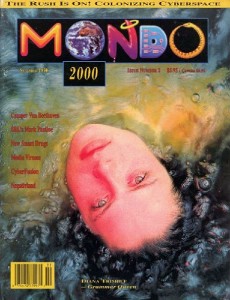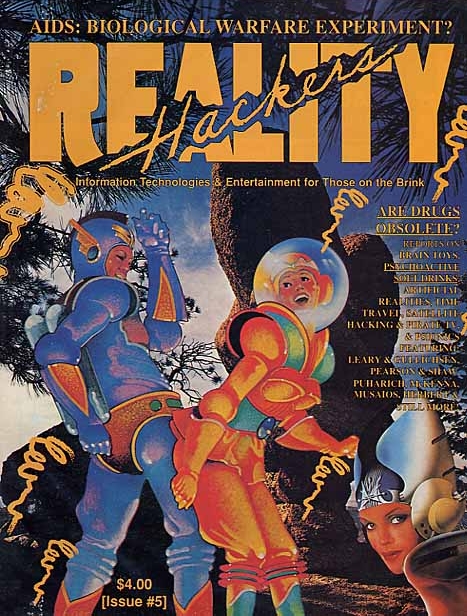Why Am I Here? Notes On Getting A Second Life
“Why am I here?†I asked myself for the twentieth time in the last hour.
I felt like a fool. Why had I allowed Shasta to talk me into this? An idle fantasy? A chance to escape the humdrum daily grind and allow myself the freedom of just being myself? This was crazy. It was going to be just like all the other times. Disappointing.
“Come to Second Life,†Shasta had said in the IM. “You can work for me at the bar I’m partners in. You’ll love it here.â€
I trusted her, I really did. Despite the fact that we had never once met IRL, Shasta has always been a friend and mentor and confidant. She has always been one of the real believers in my artistic talents, even though I have never really been a successful artist. I had known her for ten years, and tonight I was going to meet her “face to face†for the first time. Despite the fact we had been out of touch for two years, when she had found a link to my new internet account, and contacted me, it had been like we had talked only yesterday.
She had begged me to come; to see her new club and to just hang out. I had been dubious, but let her talk me into it. I had downloaded the program, set up an account, and signed into the virtual world of Second Life.
I had been in Massively Multiplayer Online Role Playing Games before, and while I liked a few, like Ragnarok and Lineage 2, I wasn’t expecting much from Second Life. It seemed kind of tame actually, a world with no story line, no monsters, no combat outside of a few arenas. I expected it to be rather boring. Indeed, just figuring out the basic interface had been confusing, and seemed rather poorly laid out compared to several other MMORPGs I had played recently. Just figuring out how to make the Avatar of myself had taken most of the hour, it had so many customization options. It took a while, and some aspects of the Avatar really were not well done, particularly hair, but finally, here I stood on the entry platform, a tall white haired bombshell in a tight red top and black mini.
No, I didn’t look anywhere near my IRL appearance, but that was the point, no? I was here not as the person I was stuck being in RL, but as Valkyrie Ice, Succubus. For nearly 20 years, from the days of BBS’s and my first appearance in one of the innumerable Red Dragon Inns, Valkyrie Ice has been my online persona and more me than the person I have to pretend to be from day to day. In “real†life, I have to spend too much of my time being what other people want me to be, from the good little drone work wants to behaving the way people expect me to just to keep the guys in white coats from coming to take me away. Additionally, as a Transsexual, only online am I free to just be myself; free of the expectations of my RL physical appearance, social status, and gender.
But I didn’t feel right. Sure I was roughly looking like I should, at least insofar as my human form went, but that has always been the problem with MMORPGs. I could never get an avatar that was really “ME.â€Â Call it delusion, past life experience, wishful thinking, whatever, I have always had dreams of being a succubus, a real cloven hoofed, bat winged, spade tailed, and rams-horned demoness with a mischievous and flirtatious streak a mile wide, but not a real gram of evil intent in my body. SL’s Avatar could be made to match the overall form of face and body, but I was still all too human, and once more feeling like I was wearing yet another mask over my real self. I was half expecting this to be yet another teaser that ended up just being more frustration than fun in the end despite Shasta’s assurances.
And to top it off, I was a human about to walk into a virtual furry strip club.
Yeah, you heard right. In my daily life, I am L. S. McGill, furry pinup artist without a following, once published in the American Journal of Anthropomorphics. For those of you who have no clue what Anthropomorphism is; it means giving human characteristics to nonhuman things, such as animating a toaster. Generally though, it is commonly used as a classification for the millions of people like me who feel that they are not “human†at heart, and are instead part animal. Be it anime cat girls, werewolves, humans with animal ears and tails, right down to full animal forms with human intelligence and speech capabilities, Anthros, or “Furries†make up a significant portion of the online community, and can be found almost everywhere. Go to almost any fan convention, and you will undoubtedly find some furry costumes, furry merchandise, and of course, Furry fans. I’ve been drawing furry art most of my life, and despite various attempts to break into the market, I’m still a failure with talent, and a life plagued with bad luck, poverty, and one setback after another. I am a very good artist, but have difficulty getting my work out where it can be seen and sold. Basically, I am creative, bright, intelligent, and cursed with an inability to ever get anyone to actually notice any of those things since all anyone ever seems to see is the fact that I am built like a linebacker for the NFL.
Obviously, in the “real†world, if you’re a giant, the only thing you could ever possibly be good at is sports or physical labor. God forbid you ever want to actually use your brain to make a living. Being an artist is even worse, since no one who is 6’5†could possibly do anything other than smash things into the ground. My talents and my A+ certification seem to mean less to employers than my size, so I’ve been forced to make my living most of my life as a bouncer. My hesitation at the moment wasn’t about walking into a strip club, since I’d worked those for years, it was the fact that for the first time, I wasn’t going into a club as security.
For the first time in my life, even though it was virtual, I was going to leave the shadows at the edges of the bar and step on the stage as one of the dancers.
“This is stupid. I’m going to make a fool of myself,†I muttered to myself as my fingers hovered over the keyboard and mouse.
Part of my hesitation was the fact that it had been obvious that the furry avatars in Second Life had been little more than an afterthought. The stock AV was a fox-like head that looked horrible. It was too big for the body, and looked like a cheap mascot head from Disney world, little more than a sphere with eyes included as part of its texture, and ears and a muzzle tacked on. The human Avatars were far more complex, with moving eyes and mouths, and extremely customizable, but I had been a furry artist for too many years to think that most furries would settle for a human face, or really want to see a dancer who looked “too humanâ€. If I had my wings and tail and horns, I might have been a little more confidant, but I had known too many furries to who even my drawings of myself in full succubus form had been “too human.â€Â Now, as succubae are shape shifters, I could get around that by simply altering my appearance, and had for several years described myself as a white unicorn anthro with sapphire blue hair and mirror polished hooves, horn, and nails, named China Blue. But I had gotten as tired of those masks as all the others and I was going to be making a real attempt to simply be myself… my real self… instead of yet another mask. Don’t get me wrong, I like being a shapeshifter, but I was hoping for once to be able to be the me I usually hid away from everybody.
I sighed, then finally stepped off the platform and made my way down the path to the novice island.
* * * * *
If you’ve ever played any MMORPG than you should be familiar with the concept of a Novice area. It’s were newbies to the game can familiarize themselves with the basics without annoying the experienced players. Second Life was no different. I ran through the tutorials about movement, camera controls, and how to move and use objects, taking my time and trying to memorize enough to avoid making a complete fool of myself. By the time I was done, I had mixed impressions about the interface. For one thing, it was complex. I had controls for camera movements, self movement, and object use, which was pretty standard, but I also had a dozen options I could see no real use for yet. I gave up after learning the basics, figuring I’d be unlikely to use the object creation menus, or any of the editing features anytime soon. Once I was confident I could navigate around, I decided to look up Shasta and find out how to get to where she was.
“Hi Val,†came the return IM a few minutes later. “I’m a little busy at the moment, but I can send you a TP.â€
Yeah, I was dumb. “Um, what’s a TP?â€
“A teleport request. It’s the most common way to get around.â€
A second later, a blue sign popped up on my screen saying Shasta had asked me to join her in Hydrangea, the name of the area where she currently was in the virtual world of SL. I clicked on the yes button and suddenly found myself falling through a grey void.
Okay, okay, so it wasn’t quite that instantaneous. I had to wait a few seconds while a load screen appeared and so on, but my arrival in mid air was a bit of a shock. Before I could hit the page up button to fly though, I landed, and the grey void started filling in around me.
And I suddenly started seeing what made Second Life so attractive.
Shasta filled in at first, and in a few seconds, she had gone from grey to the familiar form I had seen described, and even sketched a few times, but this wasn’t the typical furry cartoon art, this was a 3D person standing before me, with a raccoons head that looked far more realistic than the default furry AV had, a full body fur pattern with a creamy colored belly fur, dark brown main coat, and black “socks†on her hands and feet, and, of course, the obligatory banded tail.
I blinked. “Oh My God…â€
“Welcome to Second Life, Val,†she said, a small text balloon forming over her head as my chat box duplicated her text. Then a small blue box popped up asking me if it was okay if Shas hugged me. Still kinda in a daze I clicked yes, and found myself suddenly animated, stepping forward to embrace Shas in a virtual hug so much more real than the typical *hug* of IMs. “We’re setting up a stage at the moment, but if you’ll hang out for a few, we’ll take you out shopping to get your AV all spruced up.â€
Without thinking, I nodded, then smiled at myself as I typed, “Sure.â€Â I looked around and found a stool nearby, with a funny little pink ball hovering over it. I had learned how to use objects on the newbie island, so I tried right-clicking, and sure enough, a menu with the option to sit popped up, and my AV jumped over to the chair and sat down facing the “stage†in front of me.
That right there made me stop and think. It’s a virtual world, my AV doesn’t get tired of standing, but I had automatically taken a seat through an unconscious reflex. I had reacted exactly like I would have had I been there in the flesh.
Now, go to most MMORPG’s and sitting is a function often used to speed up your recovery of hit points and so on, but what I had just done hadn’t been anything like that, I had simply taken a seat out of the natural human response to seek comfort.
Immersion is a word often bandied about in video game circles, but if you really look at most games, this immersion is almost always limited. It basically is how much the player feels like they are actually in the game, and it is the little details that truly accomplish this. In most first person shooters, especially the Id series such as Doom and Quake, they sacrifice realism in level design for various traps, puzzles, and cubbyholes that give cover for player verses player combat. This means that often times my feeling of immersion is disrupted by a sudden nonsensical obstacle, or by illogical architecture created simply to make it hard to go from A to B. My favorite games have always been those where the environment around me made SENSE from a real world standpoint.
I had been in numerous bars and clubs, and their virtual counterpoints, and in most of the virtual ones, chairs might have been part of the décor, but to have a completely customized animation solely for sitting in one? For the next few minutes I bounced around from the stool to a couple of nearby couches, smiling. It seemed a lot of thought had gone into designing the animations used to make them as realistic and natural as possible.
Then I actually paid attention to what Shas and another employee were doing, and had to giggle. They were fine tuning a dance ball, basically an object that contains an animation routine that can be used by anyone, much like the pink ball that hovered over the stool I was sitting on. She and the other person were hovering in mid air, being moved back and forth as Shas adjusted their relative positions, making sure they actually looked like they were touching, but not overlapping too much, and making sure they weren’t in the floor but on it. During this process they were frozen like mannequins, but when Shas closed the edit menu, suddenly they were doing a swing dance.
I watched, amazed as their AVs swirled and embraced, circled and swung, and began to get a glimmer of what was in store for me as a dancer at the club. I started looking around and clicking on various items around the room I was in, noticing for the first time that many had Dance! as an option, and suddenly a lot of my nervousness eased up. I really would be able to dance here, the way I had always dreamed of.
Except… well… I still looked a bit too much like a Barbie doll. This being a strip club, I knew getting naked was part of the fun. “So does this game blur out the naked AV like The Sims does?â€Â I asked.
I heard a laugh over the speakers as Shasta replied. “Nope.â€Â Then her clothes vanished, and I discovered another thing that the default AVs lacked that could be supplied by the customizations… Anatomical correctness. I was grinning like an idiot now.
“Oh my. I really do hope we can find the things I need to make myself look right.â€
I’ll be honest. As a succubus, I am vain. I knew how I wanted to look, how I had looked in my dreams for so many years, and I didn’t want to settle for good enough. I wanted to be the star attraction, the “ZOMG she’s fucking gorgeous†babe that made tongues roll out like cartoon animations, and for once, I was starting to think that here in SL it might be possible. It wasn’t going to be enough to just have horns and hooves and wings – I wanted to have some that looked damn good.
Shas kept reassuring me that we could probably find everything I needed someplace or another. I heard about Skins, which are the graphics covering the 3d Avatar model, Prims, which is short for primitives – basically an item made out of simple shapes that is built up like legos into whatever the creator wants, such as Shasta’s raccoon head and tail – and clothing, which went over the basic shape and skin.
Following her adjustments to the dance ball, she showed me how to run a search and we headed to a mall, which in Second Life is pretty much the same as in Real Life, a building containing lots of smaller stores.
After 2 hours teleporting from one mall to another, I had begun to despair. Oh there were horns, and tails, and wings and hooves galore, but nothing that really matched my desires. I had settled for the moment for a set of wings and a tail bought from a store called appropriately enough “Devil Girlsâ€, as well as new hair, new clothes, new shoes, and some other oddments, like a walk animation override that changed the default quick step walk into a more sexy hip swaying stride, but it was becoming obvious that I might have to find other options to match my self-image exactly.
So we teleported back to the club, along with a couple of new friends I had made when Shasta had invited them to join us shopping, Jo and Greytail. Shas had to go, but GT and Jo stayed behind to help me get everything I had just bought fitted and adjusted. You see, having the ability to adjust almost every aspect of your avatar also means that not everything bought off the rack fits just right, so you do have to tweak the spatial relationships relative to yourself when you wear objects. It didn’t really take me long to figure out the controls for xyz coordinates and xyz rotations, nor did stretching objects, but had Jo and GT not shown me how to be able to adjust not only objects, but sub-objects within a larger object, I might have been screaming in frustration soon. Then GT showed me how to make objects, and in just a few minutes I had ditched the rather cheesy horns that I had bought as part of the devil girls set for a pair that actually looked like I thought they should that GT made for me on the spot.
And that’s how I learned about the uses for the object creation menu, and started realizing something vitally important about SL that made it completely unique from every other game I had ever played, and made me begin to look at it in an entirely new light.
Second Life isn’t a game in the usual sense. It’s a simulation, an emulation of the real world, but unlike any other, it’s a simulation that is not 90% developer based.
Unlike The Sims, or all the virtual IM chat programs, or any other program I had seen in years, Second Life is almost entirely the creation of its players.
That’s right, it’s Players. Its end users. Not Linden Labs, the developers of Second Life, not the programmers who know how to hack and hexadecimal edit game files, not the few, the select, the elite. Those people were all in SL to be sure, but they weren’t the people who had made SL what it was. Linden Labs had created a framework, but even they weren’t responsible for what SL was.
No, SL was something completely new in my experience, and quite possibly everyone else’s as well. It was a world created by the people who lived in it. It was a reflection of their hopes, dreams and desires. It wasn’t a product of a singular vision, or a unified set of ideas, this world was a hodgepodge collection of everything.
In the mall I had been shopping in, not only were there wings and hooves and tails, but they also had X-wing fighters, Stargates, and teleporters. Amazon fantasy armor sold right next to the full body powered armor Hardsuits from Bubblegum Crisis. Besides the various furry AVs for sale, there were Demons and Goths and Dark Elves. Cyborgs-ranging from such simplicities as wrist claws and armored exoskeletons to things as intricate as the full Terminator T101 series endoskeleton-could be found for sale next to Japanese schoolgirl outfits and fairy tale princess dresses. Be it Anime, Fantasy, Sci-Fi, or just everyday, it all had equal space. I could have dressed in jeans by Bugleboy, or a Gorean slave girl outfit, or Stormtrooper armor, and walked through that mall and no-one would have batted an eye. I had the absolute freedom to be exactly who I wanted to be, and the only real restrictions were social, so I would want to wear an outfit that hid the appropriate spots if I traveled to a PG rated zone, or if I was just wandering around, but I would have done that anyway. The point wasn’t the clothes, it was my freedom to be myself that mattered. And all around me were things that told me that that exact freedom was what mattered to everyone else as well.
Second Life was the world its residents wanted. Not a world that they had to cope with, or survive in, it was the world they desired. From sex animations to Space Stations to Angel wings, everything around me was something someone had made simply because they wanted too, and had decided to share with everyone else for a minimal recompense. Regardless of status, race, social position, or interests, everyone was free to create, to dream, and to make into a kind of reality. Everybody had an equal footing.
And that is also why I constantly use Second Life and my experiences there as examples in my writing – because Second Life is a model, a prototype if you will, for our world in twenty to thirty years. It’s the future that we would make if there were no limits to the possible, if our every fantasy and wish could be made real, and as such, despite furries and demons and aliens everywhere, it offers an insight into the very things that make us human, stripped away of the extraneous deadweight of prejudice and preconception. Like a non-stop fan convention, all of us in SL were role-playing characters, but unlike a fan con, the majority weren’t playing someone else’s creation, we were playing the person we really felt we were.
It took awhile, and I had to learn how to make objects on my own before I was satisfied, but I am myself in SL now. I have the body that has been part of my dreams for all of my life, and I have the freedom to go anywhere I choose without having to hide who I am. Unlike the “real†world, I was not forced to be someone I did not feel comfortable as simply because my genetics had dictated I look a certain way, or because society demanded I act a certain way due to that genetic accident. I could simply be myself.
And that made me think. Based on some of the proposed technological advancements of the near future, there is an extremely high likelihood of medical technology being able to make such changes outside of a virtual world. As a trans-sexual, I know that we can currently make a male such as myself into a passable female, but there are limitations that I find unacceptable personally. Yet those limitations grow fewer every year, and the cost of performing such surgery has dropped as they become more commonplace.
When I look at Second Life, and how the people who populate it express their “inner selvesâ€, I am struck by the fact that a desire to change how we look is one of the most commonplace urges shared by the majority of the human race. Be it as simple as dieting to lose weight to the extremes of sex reassignment surgery, we all have a desire to make our outer self match our mental self image, and before much longer, we will have the technology to do so at a cost that many will be able to afford.
There are numerous possible methods through which such radical reconstruction might be achieved, such as nanotech, biotech, or cybernetics, but the simple fact that such desires exist is almost a guarantee that some sort of method for achieving such radical alterations in human form will come into being. Like the evolution of the modern cell phone from the appeal of the concept of communicators in the original Star Trek series, Second Life is a showcase of concepts, expressing the desires of its inhabitants and allowing a virtual test drive of them, so that we can see what concepts work, and which don’t. From such things as virtual land baronies to virtual banks to the legality and acceptability an adult playing a child like avatar while engaging in adult activities, SL is likely to set the course and policies that will eventually govern the development of “Cyberspaceâ€, the term coined by William Gibson for the virtual reality world which co-exists and interacts with the real word in his “cyberpunk†novels. Like the communicator/cell phone example above, I believe the simple existence of Second Life will create a demand in real life for the kind of things available in virtuality
It’s simple supply and demand philosophy. Demands were made that lead to the development of the supplies needed to meet the demand. Every item made in SL by a player was created to supply a demand, be it as simple as better looking hair to such complex items as large scale virtual space craft. Using myself as an example, my demand to look exactly as I had envisioned in my dreams lead to my creating a completely custom avatar, in which every item that I wear is my own creation. I own the intellectual property rights for all of it, and having now met my own demand, I have a supply available to meet the demands of others who wish to look like me, or just like a particular aspect. In a similar fashion, by the demands being met in SL, I see a demand being created in the real world for what’s available in the virtual, and that means that someone is going to be finding a way to meet that demand.
And it was this realization that first led me to begin formalizing the various observations I have been making for decades into written form. My experiences in Second Life made me begin to look far more closely and deeply into the way in which technological advance actually affect our social and political realities. Having the freedom to actually be myself showed me just how fundamentally different the world would be as that continuing advance forced us to adapt.
And that is why I am sharing that initial experience with you. Whatever you think of me, my desires to be a succubus, or my views about the radical changes we are about to undergo, I’m just a human, like you. It’s just as novel, hard to conceptualize, and even a little unnerving for me too. But I’m willing to face it without fear, and use logic, reason, and an open mind to analyze it,


















